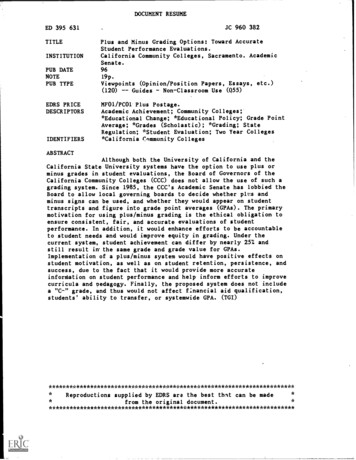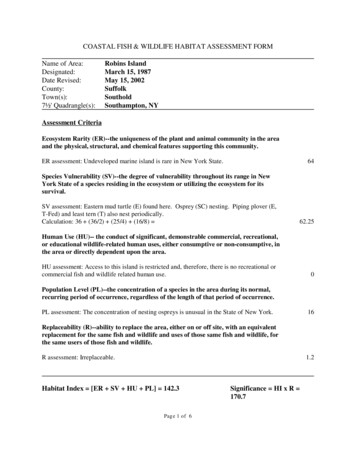
Transcription
DOCUMENT RESUMEJC 960 382ED 395 631TITLEINSTITUTIONPUB DATENOTEPUB TYPEEDRS PRICEDESCRIPTORSIDENTIFIERSPlus and Minus Grading Options: Toward AccurateStudent Performance Evaluations.California Community Colleges, Sacramento. AcademicSenate.9619p.Viewpoints (Opinion/Position Papers, Essays, etc.)Non-Classroom Use (Q55)(120)GuidesMF01/PC01 Plus Postage.Academic Achievement; Community Colleges;*Educational Change; *Educational Policy; Grade PointAverage; *Grades (Scholastic); *Grading; StateRegulation; *Student Evaluation; Two Year Colleges*California Cnmmunity CollegesABSTRACTAlthough both the University of California and theCalifornia State University systems have the option to use plus orminus grades in student evaluations, the Board of Governors of theCalifornia Community Colleges (CCC) does not allow the use of such agrading system. Since 1985, the CCC's Academic Senate has lobbied theBoard to allow local governing boards to decide whether plus andminus signs can be used, and whether they would appear on studenttranscripts and figure into grade point averages (GPAs). The primarymotivation for using plus/minus grading is the ethical obligation toensure consistent, fair, and accurate evaluations of studentperformance. In addition, it would enhance efforts to be accountableto student needs and would improve equity in grading. Under thecurrent system, student achievement can differ by nearly 25% andstill result irrthe same grade and grade value for GPAs.Implementation of a plus/minus system would have positive effects onstudent motivation, as well as on student retention, persistence, andsuccess, due to the fact that it would provide more accurateinfordation on student performance and help inform efforts to improvecurricula and pedagogy. Finally, the proposed system does not includea "C-" grade, and thus would not affect financial aid qualification,students' ability to transfer, or systemwide GPA. **************************Reproductions supplied by EDRS are the best that can be madefrom the original ******************************
.ormanceE*raltiation*--.:,.-The Academic SenateforCalifornia Communiv CollegesAdopted Spring 1996BEST COPY AVAILABLEU.S. DEPARTMENT OF EDUCATIONOfhce of Educe! *nal Research and ImprosromeelEDUCATIONAL RESOURCES INFORMATIONCENTER (ERIC)001This documenthas boon reproduced asreceived from the porson or organizationoriginating it0 Minor changes have been made toimprove reproduction quality.Points ol view Or opinions stated in thisdocument do not necessarily representofficial OERI position or policy.2PERMISSION TO REPRODUCE ANDDISSEMINATE THIS MATERIALHAS BEEN GRANTED BYJ. PerryTO THE EDUCATIONAL RESOURCESINFORMATION CENTER (ERIC)
The Educational Policies Committee1995-1996Regina Stanback-Stroud, Chair - Rancho Santiago CollegeLinda Collins, Los Mcdanos CollegeJill Harmon, Fresno City CollegeJim Higgs, Modesto Junior CollegePaul Setziol, DeAnza CollegeJean Smith, San Diego Community College District - ECCRobert Smith, College of San MateoRobert Rockwell, CIO Representative :Mt San Jacinto3
TABLE OF CONTENTSIntroduction1Current Regulations2History2Academic Senate Resolutions4Board of Governors Actions5Academic Senate Response5Plus/Minus Grading Option Proposal6Accuracy7Student Equity in Grading8Effect on Motivation10Effect on Student Retention, Persistence, Success11Effect on Financial Aid Qualification13Effect on Ability to Transfer13Effect on GPA144,
IntroductionBecause the Regents of the University of California and the Trustees and administration ofthe California State University respectively delegate to the faculty or rely upon the advice of thefaculty regarding educational policies, the academic senates in both university systems establishgrading policies. Currently all of the UC and CSU campuses have the option of establishingplus/minus grading and most use it.Despite the Board of Governors for California Community Colleges (BOG's)consultation policy that indicates that it shall rely upon the advice of the Academic Senate for.academic and professional matters, to date, the advice on the academic issue of grading policy hasnot resulted in a change in the regulation.For at least a decade the Academic Senate for California Community Colleges has urgedthe Board of Governors to pass regulations that would permit tho use of plus/minus grading at thediscretion of the local district.Primarily, for the sake of administrative convenience of reportingand receiving data, the community colleges are precluded from the practice.The fair and accurate evaluation of student performance is a fundamental responsibility ofthe faculty. In the interest of faculty accountability to the state, districts, colleges, and studentsfor having met that responsibility, the Academic Senate urges the Board of Governors forCalifornia Community Colleges to employ the same wisdom as their colleagues in the othersegments of higher education and rely upon the advice of the faculty for this academic matter.To that end, and in response to the following resolution, this paper was developed.S95 20.4Plus&finus GradingTherefore, be it resolved that the Academic Senate for California Community Colleges reaffirm itssupport for the permissive use of plus/minus grading; andBe it further resolved that the Academic Senate for California Community Colleges direct the
Executive Committee to present a specific proposal for a plus/minus grading system, including Title5 implications, to a future session.Current regulationsTitle 5, Section 5575.8 establishes the academic record symbols and grade point averagecomputation. The table below lists the evaluative symbols, definitions, and grade point values asestablished in the regulation.SymbolDefinitionGrade PointAExcellent4Good3Satisfactory2Passing, less than satisfactory0FailingCRCredit (at least satisfactoty-unitsawarded not counted in GPM)NCNo Credit (less thsn satisfactory, orfailing-units not counted in GPM)*GPA Grade Point AverageWhile the regulations also allow non-evaluative symbols including (I) Incomplete, (IP) InProgress, (RD) Report Delayed, and (W) Withdrawal, by establishing the above listed evaluativesymbols, the affixation of plus or minus signs to the grades is not permitted.HistoryPrior to the 1968 establishment of the Board of Governors for California CommunityColleges (BOG), standards for the community colleges (then junior colleges) were declared by theCalifornia State Board of Education (currently K-12). The regulations were silent on the affixing26
of plus/minus symbols to grades.' To that end, faculty were not precluded from using plus/minussymbols.With the establishment of the BOG, community college regulations including those thatgovern grading practices were established. In response to districts' request for flexibility, theregulations were amended to permit a district governing board to develop a grading scale otherthan the A-F letter grading system.' The regulations were changed to include "The governingboard of a district maintaining a community college shall determine the grading practice to beused in that community college. The grading practice shall be based on sound academicprinciples."3Following the change to permit local district governing boards to establish the gradingsystem, a wide variation of grading systems were used. In response to a report by the CaliforniaPostsecondary Education Commission, Through the Open Door, that included criticisms thatCalifornia Community Colleges maintained inconsistent and educationally questionable gradingpractices, and with lobbying from the Academic Senate for California Community Colleges(Academic Senate), the Chancellor appointed a Grading Policies Study Group.4 For the sake ofconsistency, uniformity, and administrative convenience, the group recommended that plus/minusgrades be precluded. 5'Klein, Chtu lie, Educational Standards and Evaluation - Chancellors Office of the California CommunityColleges. Plus Minus Grading, (May 5, 1989) p 32Klein, Charli-, p 33Califomia Community Colleges, Board of Governors Agenda Item4Klein, Charlie, p 4sKlein, Charlie, p 437(April 1971)
Academic Senate ResolutionsAt the Fall 1985 Plenary Session of The Academic Senate for California CommunityColleges, the following resolution was passed.Be it Resolved that the Academic Senate for California Community Colleges recommendthat pluses ( ) and minuses (-) be included in the standard grading policy for theCalifornia Communio Colleges and that the Executive Committee be directed to promotethis as a standard higher education grading policy through the intersegmental senate, toinsure equitable grading procedures.Although the Academic Senate communicated the resolution to the Board of Governors and theChancellors Office, no progress was made on the issue.At the Fall 1987 Plenary Session of The Academic Senate for California CommunityColleges, the following resolution was passed.Be it Resolved that the Academic Senate for California Community Colleges reaffirm itspast support for the position that California Community College faculty be authorized toissue grades of plus or minus on a campus by campus basis, thereby better following theUniversity of California grading system.Tb passage of this resolution created confusion because the initial resolution promoted astatewide imposition of plus/minus grading. The latter resolution called for local determination ofthe use of plus/minus grading. To that end, there was communication between the AcademicSenate and the Chancellor's Office staff to clarify the issue. The Academic Senate indicated theFall 1987 resolution calling for permissive use of pius/minus grading to accurately reflects itsposition and desire.The Academic Senate proceeded to gather grading policies from the various University ofCalifornia (UC) and the California State University (CSU) campuses. These policies were madeavailable to the Chancellor's Office staff in order to support their work in making a4
recommendation to the Board of Governors.Board of Governors ActionIn May, 1990, the BOG considered a recommendation to amend Title 5, Section 55758 toinclude:"(b) The governing board of a community college district may approve the use of "plus"and "minus" designations in combinations with letter grades, and may compute gradepoint averages taking plus and minus values into account. In said computations, thevalue of a plus grade shall be computed by adding .3 to the value of the letter gradewhich it is combine4 and the value of a minus grade shall be computed by subtracting .3from the value of the letter grade with which it is combined, except that no grade pointvalue shall be less than 0 or greater than 4.0. "6This recommendation was the result of consultation and staff research. Based on opposition fromthe representative of the Council of Student Body Government (CSBG), the BOG rejected therecommendation citing concerns about equal access to plus/minus grades, possible loss offinancial aid, possible problems with transfer, and speculations of grade point average (GPA)decline.Academic Senate ResponseSubsequent to the BOG action, the Academic Senate has had numerous meetings with theCSBG. The proposal has been modified and presentations have been made that answer theconcerns cited by the BOG based on student testimony. Depending on the year of the council, thestudents have expressed continued concern or support. The 1993-94 and 1994-95 the CSBGexpressed support and identified thr plus/minus grading could be beneficial to students.At the Fall 1995 Plenary Session of The Academic Senate for California CommunityColleges, the following resolution was passed.6Cahlomia Community Colleges, Board of Governors Agenda Item 8, (May 10-11, 1990) Attachment A, p I59
595 20.4Plus/Minus GradingTherefore, be it resolved that the Academic Senate for California Community Collegesreaffirm its support for the permissive ,-ce of plus/minus grading and be it furtherresolved that the Academic Senate for California Community Colleges direct theExecutive Committee to present a specific proposal for a plus/minus grading system,including Title 5 implications, to a future session.Plus/Minus Grading Option ProposalThe Academic Senate proposes that the Board of Governors of the California CommunityColleges adopt changes in the regulations pertaining to student gxades of record, and that thechanges call for the following:1.Permissive use of plus and minus grading ( -) whereby local governing boards setpolicy that establishes (a) whether plus/minus grading symbols can be used incombination with the letter grades. (b) whether plus/minus symbols would appearon student transcripts and figure into GPA's. This would create the followingoptions for local districts.A.Plus/minus grades appear on the transcripts and count on the GPAcalculation.B.Plus/minus grades appear on the transcripts and do not count on the GPAcalculation.C.2.Plus/minus grades are not used at all.The Following Grading Scale is proposed for plus/minus grading. Due to trawl-, rconsiderations, a grade of "C-" is not included.A AA- 4.04.03.7C CD 2.32.0 6101.3
B BB- DDF3.33.02.7 1.00.70i.3.The plus and minus symbols would be added in the section of Title 5 on gradingand grading symbols. All other aspects of the language of the section would beunchanged.AccuracyThe primary motivation for use of the plus/minus grading option stems from an ethicalimperative. Faculty are ethically obliged to ensure evaluations of student performance areconsistent, fair, and accurate. This obligation is true whether one's grading philosophy ispredicated upon any one, two, and/or all of the three standard approaches to grading:improvement, mastery relative to an absolute skill or knowledge standard, and mastery relative toothers. In essence, the implementation of the plus/minus grading option allows for better andmore accurate information to and for students about their performance.As a directive from AB1725, the Board of Governors was required to implement acomprehensive community college educational and fiscal system of accountability. The developedsystem of accountability includes qualitative and quantitative academic standards.' This attentionto accountability is consistent with rising public and governmental concern about accountability inhigher education as public financial support for colleges and universities declines and institutionsare asked to meet growing demands with fewer resources.iAdditionally, the attention to student performance in both the secondary (K-12) and the47California Community Colleges, Board of Governors Agenda Item 9, (July 12-13, 1990), p 57I1
postsecondary (13-20 ) systems has given rise to discourse and debate about the value of thecollege and university degree. Therefore, there has been increased attention by the faculty of thecommunity college system to curriculum, pedagogy, and academic standards as evidenced by theirwork on program review, the establishment of prerequisites, curriculum approval, intersegmentalgeneral education transfer, academic disciplines minimum qualifications, and student equity.The faculty profess that the permissive use of plus/minus grading symbols facilitate theirability to be accountable for their professional obligation to the state, college, and students.Restricted by regulations that do not meet the test of substantial state interest, faculty across thestate are precluded from indicating accurate student performance evaluations. According to theChancellor's Office, "The test of substantial state interest that ordinarily must be met before theBoard enjoins an educational rule on all districts cannot be met in the case of plus/minus grading.That is, the effects, positive or negative, of adding pluses and minuses to the grading scale areeither too uncertain or not substantial enough to make a uniform, system wide minimum standardappropriate. Therefore, staff concludes on governance grounds that the current restrictiveregulations should be amended to permit the use of plus and minus affixes to letter grades."Student Equity in GradingThe current system is too coarse. Students' achievement can differ by nearly 25% andresult in the same grade and grade value for GPA purposes. Conversely, Students' achievementmay not differ by more than 1% yet result in adjacent grades 25% apart in value for GPApurposes. With the plus/minus grading option there is greater potential for the evaluationdetermined by the instructor to more accurately be reflected in the assigned grade. This statement'California Community Colleges, Board of Governors Agenda Item 9, (July 12-13, 1990), Attachment B, p.381 0 .,
is exemplified in the situation given below:Given a faculty member's grading system that establishes a 500 point total possiblefor all work and that, at the end of the term requires that faculty member to translate pointtotals into letter grades, and given the following example of a grading scale,450-500 A400-449 B350-399 C300-349 Dseveral inequities and several other problems arise from scores routinely achieved and mayexplain why, even though the regulations preclude the use of pluses and minuses as officialevaluative symbols, many faculty assign pluses and minuses to letter grades for workduring a term.Because all students do not score at the mean score of each of the letter grades,(instead students score at the full range of possibilities within a letter grade), the simpleassignment of a letter grade precludes the faculty member from accurately indicating thestudents' appropriate scare. Consider thefollowing:1.Rita amasses a total of 452 points and receives an A grade and a GPA equal to hergrade points equal to 4.0 times the course units.2.Paul amasses a total of 448 points and receives a B grade and a GPA equal to hisgrade points equal to 3.0 times the course units.3.Chuck amasses a total of 404 points and receives a B grade and a GPA equal to hisgrade points equal to 3.0 times the course units.The instructive aspects of comparing Rita to Paul and then Paul to Chuck demonstratetwo inequities in the 4.0 grading system lacking the plus/minus option.913
Rita's 452 point total is less than 1% greater than Paul's 448 points while her gradereward is 25% greater than Paul's grade of a "B". Conversely, Chuck's points total 404and are 11% less than Paul's point total of 448, yet Chuck and Paul's grade of "B" is 0%different.Additionally the unit total for the course acts as a multiplier of the effect on thetotal GPA whereby small differences in performance in high unit courses may account foras much or more effect than the difference between excellence and utter disregard in a lowunit course. With the permissive use of plus/minus grading, six pairs of adjacent gradesare 7.5% apart in value (A/A-, B /B, B/B-, C /C, D /D, D/D-), two pairs are 10%apart in value (A-/B , B-/C ), and two pairs are 17.5% apart in value (C /D , D-/F).With plus/minus grading, Rita and Paul would be no more than 10% apart as opposed to25% while Paul and Chuck would be 15% apart rather than 0%.Other concerns regarding equity centered around differences among various colleges. If afaculty member teaches at College A and College B concurrently, and College A permits the useof plus/minus grading but College B does not, students who perform the same will receivedifferent grades. This concern is not compelling, nor is it created by the permissive use ofplus/minus grading. Currently, faculty teach at community colleges and neighboring CSU or UCcampuses.There is a greater potential for different grading habita at a single college foundamong different faculty teaching the same course at a single community college.Effect on Student MotivationRecognizing that student motivation to success can have a positive impact on their abilityand willingness to achieve, the use of plus minus grading could support student motivation and1014
success. To that end, it is essential for students who are highly motivated and perform better tosee the rewards reflected in their grade. Conversely, students who have less motivation andsubmit less efforts should also see the consequences reflected in their grade.In the current system, students in sequential courses can become, in one circumstance,discouraged by having significant improvement evaluated as if there were no improvement and, inanother circumstance, complacent by having significant decline in achievement evaluated as ifthere were no decline. This point is exemplified in the situation below.Zia and Rudy have chosen the same major and are enrolled in that discipline's coresequence of courses. In the first term Zia tries hard and amasses 445 points that translatesto a B grade while Rudy is not confident, noncommittal, and amasses 405 points that alsotranslates to a B grade. In the second term, Zia is distracted by things extra-curricular andslips 40 points (10% of the possible scale) but still receives a B. Meanwhile Rudy screwsup his courage, tries hard, and raises his point total to 445 but still gets a B.In anticipation of a third term, the message received by Zia is likely to be "I cancoast since I didn't even try this term and still got a B" while the message received byRudy is likely to be "I'm not good enough. I worked a lot harder but itdidn't make any difference since I still got a B. I'll never be able to get an A".Effect on Student Retention, Persistence, and SuccessDiscussions about accountability contain frequent references to retention, persistence andsuccess. Districts throughout the state include these variables on their research agendas, in theirstate accountability reports, and in many plans related to academic programs and services. Soundeducational planning and effective program evaluation rely heavily on accurate data related to1115
students access, retention, persistence, and success. Because student performance evaluationsdirectly impact plans and goals of the college, accuracy of student performance evaluation informsthe faculty in their responsibility to examine curriculum and pedagogy in order to positively affectstudent access, retention, persistence and success.Similarly, the absence of the plus/minus grading option could lead to inaccurateconclusions drawn for the purposes of establishing course offering needs, hiring sufficient faculty,and identifying necessary student services. Under the current system, students pursuing highGPA's are under such pressure that they are predisposed to drop courses early on if they perceivetheir GPA would be negatively impacted by an anticipated grade. In dropping after the "adddate," such students prevent other students are prevented from enrolling in the course.Additionally, students may be less likely to drop a course if the lower adjacent grade had less of anegative impact on their GPA. These points are exemplified in the situation below:Marfa is a very ambitious student whereas Nthuy is unpretentious and somewhatunsure of her potential and what she. deserves. Marfa and Nthuy both intend to enroll inMath 50, a required course in their major. Marfa's registration time is before Nthuy's andshe gets one of the last seats in the class whereas the class is filled before Nthuy gets toregister. In the third week of the term Marfa gets the results of the first quiz, a B. Doingsome quick calculations, Marfa figures out that she will have to average a solid A in orderto get an A in the class. She thinks she cannot afford o get a B, both because of thepresence of a B on the transcript and, more importantly, because of the effect of the B onher GPA. She drops the course.All together then, two students wanted to take the course and neither ended up1216
completing it. Problems like these are known to precipitate unnecessary changes ineducational plans, lack of persistence through an educational plan, and, unfortunately, atleast temporary cessation of studies.Effect on Financial Aid QualificationThe students and the Board of Governors expressed concern that the permissive use ofplus/minus grading may cause some students who are receiving financial aid with a grade of C tolose their financial aid reward with a grade of C-. The proposal contained herein does not includea C- option.Effect on Ability to TransferDespite their use of plus minus grading, the minimal grade necessary to satisfy mosttransfer requirements is a C. Therefore, concerns were voiced about the dilemma a student faceshaving earned a C- in the community college, thereby not being able to repeat the course. Neithercould the student transfer. To that end, in the state of California, the student would be trappedand would no longer have transfer as an educational option.Conversations with the UC and the CSU faculty revealed the legitimacy of this concern.While admittance to the UC and CSU is unaffected by pluses and minuses, the determination ofthe status of a C- as satisfactorily meeting a major requirement is left to the individual universitiesand academic departments. Additionally, the Intersegmental General Education TransferCurriculum agreement specifies a C as the minimum passing grade for a course. This requiredminimum means at both UC and CSU a grade of C- would not qualify. While it is possible toaddress the issue in the Intersegmental Committee of the Academic Senates, our best judgement isto exclude the C- from the proposal as an option in light of these very legitimate concerns1317
expressed by the students.Effect on GPAThe 1989 Chancellor's Office report concluded that there would be a marginal decline inGPA given implementation of the plus/minus grading option.' The basis of this opinion was that,since A does not 4.3 in the proposal, there would be, in effect, more minus grades given. Thisopinion concluded, however, that the number of students who would drift down belowa 2.0 GPAand go on probation would be 1 or 2 per college. In the current proposal, given the absence ofthe C- grade, the logic used for the speculation of grade decline disappears.In a 1992 national study, the American Association of Collegiate Registrars andAdmissions Officers (AACRAO) presented various findings as part of their study. Among them:"Singleton and Smith (1978) argued that institutions that implemented plus and/or minus gradingsystems would also help their faculty in awarding more reliable grades of student performance.They noted that the predictive validity of a student's record would be more accurate if the studentwas evaluated on a plus and/or minus scale even with the existence of inflated grades. Finally,Quann (1987) acknowledged that fractionated grading systems provide for more accuracy ingrading, and therefore, they reduce assessment errors due to grouping."The "conclusions" section of the study begins:"After analyzing the data from the 1992AACRAO study, and after making comparisons between the new information and the datacollected in previous AACRAO studies, the following conclusions are offered:Colleges and universities that utilize four-point undergraduate grading systems areincreasingly making those systems more detailed and specific. The data revealed that a9Klein, Charlie, p 241418
significantly greater number of the 1992 respondents, in comparison with the 1982respondents, employ a plus and/or minus, combined letter numeric, or non-letter gyadingsystem instead of using a simple letter only grading system. This is consistent withQuann's (1987) expectation that more institutions would implement plus and/or minusgrading systems as a response to grade inflation. It may also reflect the concernsexpressed by Cole (1993), Grieves (1982), and Singleton and Smith (1978) which impliedthat a means of more accurately and specifically reflecting a student's performance isneeded.The study does not draw any conclusions about the actual GPA effects of adding thechoice of plus/minus to grading standards. The AACRAO did find a very slight decline in averageGPA among the colleges and universities studied from 1972 to 1982 but stated that theimplementation of plus/minus was not separated from an effort to curb grade inflation. Thisinterpretation means that one could not necessarily predict a decline if curbing grade inflation wasnot a primary goal. In California, students transferring from the California Community Colleges(that do not have the plus/minus grading option) to UC and CSU (that mostly do have theplus/minus grading option) have GPA'S at CSU as high or higher than CSU native students andnearly identical at UC to UC native students. Thus, grade inflation is not particularly a ground forconcern and is therefore unlikely to be a goal associated with implementation of plus/minusgrading.1519
Regina Stanback-Stroud, Chair-Rancho Santiago College. Linda Collins, Los Mcdanos College Jill Harmon, Fresno City College. Jim Higgs, Modesto Junior College. Paul Setziol, DeAnza College. Jean Smith, San Diego Community College District - ECC. Robert Smith, College of San Mateo Robert Rockwell, CIO Representative :Mt San Jacinto. 3











